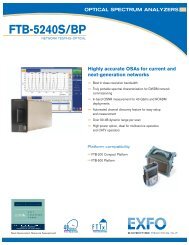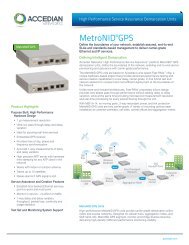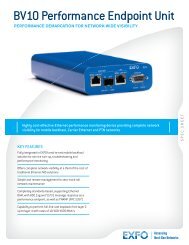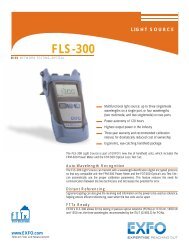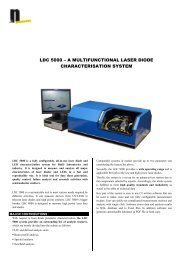live-fiber otdr testing: traffic and measurement ... - 3 EDGE GmbH
live-fiber otdr testing: traffic and measurement ... - 3 EDGE GmbH
live-fiber otdr testing: traffic and measurement ... - 3 EDGE GmbH
Create successful ePaper yourself
Turn your PDF publications into a flip-book with our unique Google optimized e-Paper software.
LIVE-FIBER OTDR TESTING: TRAFFIC<br />
AND MEASUREMENT IMPAIRMENTS<br />
022<br />
TECHNICAL NOTE<br />
Dr. Hongxin Chen, Optical Researcher, Michel Leblanc, R&D Manager <strong>and</strong> Olivier Plomteux, Sr. Product Manager.<br />
Motivations for Testing Live Fibers<br />
Monitoring equipment for detecting <strong>and</strong> locating bends, material degradations or breaks in optical <strong>fiber</strong> networks is traditionally set up on dark <strong>fiber</strong> as<br />
this provides good balance between material cost, system provisioning effort <strong>and</strong> fault detection success rate. Most monitoring systems used for<br />
physical fault detection <strong>and</strong> positioning employ OTDRs; a dark-<strong>fiber</strong> monitoring approach typically uses a 1550 nm window test unit since this window<br />
produces lower <strong>fiber</strong> attenuation, maximizing the <strong>measurement</strong> range. Skipping over terminals, amplifiers <strong>and</strong> OADMs only requires optically connecting<br />
the appropriate ports <strong>and</strong> the next segment becomes visible for the OTDR, with almost no additional loss. It is also a well-known fact that monitoring<br />
only a few <strong>fiber</strong>s within a cable geometry <strong>and</strong> structure (such at its outer part, one per tube or one per ribbon) is enough to provide information about<br />
the optical link quality.<br />
So why is <strong>live</strong>-<strong>fiber</strong> <strong>testing</strong> <strong>and</strong> monitoring generating such rising interest<br />
There may just not be enough dark <strong>fiber</strong> available to provide good fault detection sensitivity.<br />
In many situations, degradations can be very local (such as a connection removed voluntarily or not, a worn-out splice, aerial cable damage due to<br />
bullets, rodents, sabotages where only a few outer <strong>fiber</strong>s were cut). So depending on the regional problems that are experienced or foreseen, the<br />
dark-<strong>fiber</strong> logic may not apply. In these cases, <strong>live</strong>-<strong>fiber</strong> monitoring or <strong>testing</strong> becomes the only solution that can provide complete surveillance.<br />
More importantly, optically <strong>testing</strong> <strong>live</strong> segments is a straightforward method to correlate transmission <strong>and</strong> physical path errors. In a long-haul<br />
system, more than 100 km can separate two network elements, a considerable distance to deal with if the only information is a B1 byte status<br />
change, signaling a specific section fault in the SONET/SDH section overhead coding. In metro, core or access networks, the trend is to remove<br />
expensive fast-detecting <strong>and</strong> processing electronics by optically switching paths, which directly remove points of surveillance between destinations.<br />
Unless these intelligent optical switches can embed an optical surveillance function, this movement drives the need for <strong>live</strong>-<strong>fiber</strong> <strong>and</strong> optical signal<br />
monitoring.<br />
Deploying OTDR-based <strong>live</strong>-<strong>fiber</strong> <strong>testing</strong> <strong>and</strong> monitoring requires solid underst<strong>and</strong>ing of the stimulated Raman scattering (SRS) cross-effects between<br />
the OTDR’s high-power pulses emitted in wavelength windows such as 1625 nm or 1650 nm <strong>and</strong> the <strong>traffic</strong>, generally emitting in the C <strong>and</strong>/or L b<strong>and</strong>.<br />
To some degree, Raman scattering can affect both the OTDR dynamic range <strong>and</strong> the <strong>live</strong> signals. Minimizing stimulated <strong>and</strong> spontaneous Raman<br />
scattering is therefore a must in order to achieve seamless integration of OTDR-over-<strong>traffic</strong> signals. For our purposes, we will not specifically address<br />
the additional loss caused by wideb<strong>and</strong> multiplexers used for injecting (<strong>and</strong> by-passing active elements) OTDR signals into <strong>live</strong> <strong>fiber</strong>s; however, it is<br />
common underst<strong>and</strong>ing that these devices basically reduce the margin on transmit/receive lines by few dBs. This technical note provides some<br />
experimental results <strong>and</strong> a few design rules to adequately address the Raman scattering problem.<br />
www.EXFO.com<br />
Telecom Test <strong>and</strong> Measurement
Technical Note 022<br />
Spontaneous Raman Scattering (SRS)<br />
Raman scattering can be spontaneous <strong>and</strong> eventually stimulated. The phenomenon starts occurring when signals in the medium get to an intensity level<br />
at which a small fraction of the incident wave starts generating new frequency-shifted waves propagating in both directions. This spontaneous emission<br />
occurs due to the <strong>fiber</strong> medium's vibrational modes, widely spread around the Raman gain peak, whose frequency is about 13 THz from (~100 nm)<br />
the pump’s wave frequency. Spontaneous Raman scattering, which is usually a negligible feature for transmission system, becomes an important<br />
limitation for <strong>live</strong>-<strong>fiber</strong> monitoring. This is due to the fact that a non-negligible fraction of the <strong>traffic</strong> signal is scattered in the OTDR wavelength b<strong>and</strong> <strong>and</strong><br />
adds to the Rayleigh backscattering measured by the OTDR.<br />
Stimulated Raman scattering is a well-known limitation for ultra-high-power transmission. As its threshold is in the 1 to 2 W range, it is usually negligible<br />
for low- to medium-<strong>traffic</strong> power level. In the context of <strong>live</strong>-<strong>fiber</strong> monitoring with long wavelength OTDR, the WDM <strong>traffic</strong> acts as a pump <strong>and</strong> the OTDR<br />
pulse acts as a signal that is being amplified. Since the OTDR power provides a seed for the amplification, Raman gain can be experienced at a power<br />
well below the usual threshold for stimulated Raman scattering. In the case of an OTDR pulse propagating at a wavelength where Raman gain exists,<br />
the OTDR pulse will acquire energy from the <strong>traffic</strong> <strong>and</strong> experience some gain. This energy transfer depletes the <strong>traffic</strong> bits amplitude.<br />
The parameters that can control the amount of SRS are the following (somewhat in order of importance):<br />
The transmission, or pump, signal intensity <strong>and</strong> distribution along the <strong>fiber</strong><br />
The OTDR pulses peak power level <strong>and</strong> propagating direction (co- or counter-propagating relative to pump)<br />
Difference in frequency between the pump <strong>and</strong> the seed (here, the OTDR pulse)<br />
The <strong>fiber</strong> type used for transmission, from which a Raman gain coefficient is derived<br />
Experimental Setup<br />
In order to measure this effect, we used a simple setup as shown in Figure 1. The setup reproduces a typical <strong>live</strong>-<strong>fiber</strong> RFTS system, except that the<br />
<strong>traffic</strong> is replaced by an amplified CW signal.<br />
OSA<br />
PM<br />
25-75 km SMF<br />
LD<br />
(1550 nm)<br />
EDFA<br />
1/99<br />
F1<br />
W<br />
D<br />
M<br />
1<br />
A<br />
W<br />
D<br />
M<br />
2<br />
F3<br />
VOA<br />
PD1<br />
OTDR<br />
(1625 nm)<br />
F2<br />
F4<br />
PD2<br />
Figure 1. Experimental setup for <strong>live</strong>-<strong>fiber</strong> <strong>testing</strong> assessment<br />
www.EXFO.com<br />
Telecom Test <strong>and</strong> Measurement
Technical Note 022<br />
Item Description/Model Comment<br />
LD<br />
EXFO IQ-2400 DFB Laser with low SBS<br />
settings<br />
Power: 2.5 dBm<br />
Wavelength: 1550.2 nm<br />
EDFA EAD-10-C (IPG-Photonics) Used as a booster<br />
F1, F3 BFC-16-13/15-N-9-1 (DICON) 1625 nm b<strong>and</strong>; blocking filter<br />
F2, F4 BFC-13/15-16-N-9-1 (DICON) 1310/1550 nm b<strong>and</strong>s; blocking filter<br />
WDM1, WDM 2 FCW-13/25-166-N-9-1 (DICON) Three ports; 1625 to 1550 nm; WDM<br />
PD1, PD2 Photodetectors PIN with 50Ωload<br />
OSA<br />
EXFO IQS-5250B OSA<br />
PM EXFO IQ-1103 Power monitor<br />
VOA EXFO FVA-60B-850-RS Variable attenuator<br />
OTDR EXFO IQ-7534B-B-E1 1625 nm<br />
SMF SMF-28 (TM) Fiber 3 x 25 km <strong>fiber</strong> rolls<br />
SCOPE hp Oscilloscope: 54520A 500 MHz (not shown)<br />
The configuration uses a single-wavelength source at 1550 nm. Due to the broadb<strong>and</strong> nature of Raman interaction, a setup with only one wavelength<br />
representing the <strong>traffic</strong> is believed to be representative of the impact of a multiwavelength system (WDM). In first approximation, this is true when the<br />
total power <strong>and</strong> wavelength range of a WDM system is equal to the power <strong>and</strong> central wavelength of a single-channel system.<br />
Traffic Depletion<br />
When the <strong>traffic</strong> <strong>and</strong> the OTDR are co-propagating, all of the energy transferred to the OTDR originates from the bits that are ‘synchronized’ with the<br />
OTDR pulse (see Figure 2). This will cause a sudden depletion of the <strong>traffic</strong> amplitude. This sudden reduction of power may cause a significant BER<br />
increase. In the case of counter-propagation, the OTDR pulse takes energy from different ‘parts’ of the <strong>traffic</strong> signal so the effect on the <strong>traffic</strong> will be<br />
much less severe (in fact, it can be neglected). The gain on the OTDR pulse is expected to be roughly the same for co-propagating <strong>and</strong> counterpropagating<br />
directions<br />
OTDR<br />
(1625 nm)<br />
WDM signal<br />
(1550 nm)<br />
Figure 2. Amplitude of WDM signal as a function of time (co-propagation).<br />
www.EXFO.com<br />
Telecom Test <strong>and</strong> Measurement
Technical Note 022<br />
The experimental <strong>measurement</strong> <strong>and</strong> theoretical prediction of the WDM depletion as a function of pump power (WDM power) <strong>and</strong> OTDR power is<br />
shown here for a co-propagation case.<br />
Figure 3.Graphic representation of WDM depletion vs. power<br />
Figure 3 (left) illustrates an experimental <strong>measurement</strong> of WDM depletion (circles) <strong>and</strong> theoretical prediction (thin solid line) as a function of WDM<br />
pump power for an OTDR power of 8 mW (25 km SMF). The dotted line represents the theoretical WDM depletion in the case of a 50 mW OTDR<br />
<strong>and</strong> a 100 km SMF link. The figure on the right shows an experimental <strong>measurement</strong> of WDM depletion (circles) <strong>and</strong> theoretical prediction (solid line)<br />
as a function of OTDR power for a WDM signal power of 50 mW (5 km SMF).<br />
These figures demonstrate that the percentage of depletion is not affected much by the <strong>traffic</strong> power. The depletion is significantly more affected by<br />
the OTDR power. In this experiment, we used the more powerful 1625 nm OTDR available (IQ-7504, 100 mW laser), less the component loss between<br />
the OTDR <strong>and</strong> the <strong>fiber</strong> spool. Looking at the dotted line in Figure 3 (left), we can see that the depletion will be important if a high-power OTDR signal<br />
is injected efficiently in a <strong>fiber</strong>. Accordingly, using high-power (large dynamic range) OTDRs in co-propagation situations would not be recommended.<br />
OTDR Distortion<br />
We know that the energy lost by the <strong>traffic</strong> is transferred to the OTDR pulse. This causes some OTDR pulse amplification as it propagates through the<br />
<strong>live</strong> <strong>fiber</strong>. The OTDR trace will be distorted accordingly. A lower apparent attenuation will be observed on the OTDR trace as seen in Figure 4.<br />
Figure 4. OTDR trace, with <strong>and</strong> without the presence of <strong>traffic</strong>.<br />
www.EXFO.com<br />
Telecom Test <strong>and</strong> Measurement
Technical Note 022<br />
An OTDR Raman gain of 1 dB will not cause any significant problems if the reference trace <strong>and</strong> further acquisitions are taken with a similar level of<br />
<strong>traffic</strong>. As we will see next, the significant increase in noise floor clearly shown in Figure 4 occurs well before distortion appears as a limiting factor.<br />
The experimental <strong>measurement</strong> <strong>and</strong> the theoretical prediction of the OTDR gain (Raman gain) as a function of WDM power is shown here for a 25 km<br />
link of SMF <strong>fiber</strong>.<br />
Figure 5. OTDR gain (Raman gain) as a function of WDM power for a 25 km SMF <strong>fiber</strong>, experimental data (dot) <strong>and</strong> theoretical data (solid line)<br />
for a 10 mW OTDR pulse power.<br />
OTDR Penalty Due to Spontaneous Raman Scattering<br />
The most troublesome impact that can be seen in Figure 4 is the rise in noise floor on the OTDR trace. This is due to the presence of significant<br />
spontaneous Raman noise scattering. Since this noise is created in the supervisory 16xx nm region, it is directed toward the OTDR port by the RFTS<br />
WDM coupler.<br />
Figure 6. Raman scattered noise spectrum measured at the OTDR port with a 1 nm OSA resolution b<strong>and</strong>width for a 16 dBm WDM power.<br />
www.EXFO.com<br />
Telecom Test <strong>and</strong> Measurement
Technical Note 022<br />
WDM Signal<br />
power (dBm)<br />
Backward spontaneous noise<br />
at OTDR (dBm)<br />
+8 —48.5 3<br />
+2 —54.5 2<br />
—3 —59.5 1<br />
—6 —62.5 0.5<br />
—10 —66.5 negligible<br />
OTDR dynamic range<br />
penalty (dB)<br />
Table 2. OTDR penalty measured as a function of transmitter power (1546 nm) for a 50 km SMF link (co-propagation)<br />
We see that there is roughly a 52 dB difference between the 1550 nm of injected power <strong>and</strong> the 16xx nm of backscattered power. Even if the<br />
backscattered signal is very low, it is known that the presence of a –60 dBm CW power injected toward the OTDR output port raises the OTDR noise<br />
floor. The maximum <strong>traffic</strong> power allowed in co-propagation is –3 dBm so that no significant penalty is applied to the nominal OTDR dynamic range.At<br />
–40 dBm, the OTDR will stop working because of receiver saturation. This is certainly the most important limitation to <strong>live</strong>-<strong>fiber</strong> monitoring at 1625 nm.<br />
When the <strong>testing</strong> or monitoring is performed in the counter-propagation direction, it is the forward spontaneous Raman scattering that becomes critical.<br />
For a 25 km SMF link, the forward <strong>and</strong> backward spontaneous Raman scattering values are very similar (only a few dB difference). However, on a longer<br />
link, the forward scattering that is measured at the output of the <strong>fiber</strong> decreases compared to a shorter link. This is because most of the scattering is<br />
generated in the first part of the link (say, the first 30 km) <strong>and</strong> is then attenuated by the remaining <strong>fiber</strong>. So for a long link, monitoring in counterpropagation<br />
will be less affected by the added noise due to spontaneous Raman scattering. For a long link (100 km), forward scattering will be 12 dB<br />
lower than backward scattering.<br />
Effects Summary<br />
Coupling an OTDR to a <strong>live</strong> <strong>fiber</strong> for <strong>testing</strong> purposes requires adding WDMs <strong>and</strong> filters to protect transmit/receive equipment from the backscattered<br />
or transmitted OTDR signals. Component insertion loss, isolation <strong>and</strong> cross-talk specifications are the first issues to consider in the implementation of<br />
<strong>live</strong>-<strong>fiber</strong> OTDR <strong>testing</strong>. Once the link loss budget is established with these new components, system engineers, helped by EXFO technical staff, should<br />
evaluate the impact of SRS on both the OTDR performance <strong>and</strong>, eventually, on <strong>traffic</strong> depletion.<br />
The principal limitation to <strong>live</strong>-<strong>fiber</strong> monitoring at 1625 nm (<strong>and</strong> any wavelength within a large range about 100 nm beyond the transmitting signals), will<br />
come from the spontaneous Raman scattering noise that reaches the OTDR port. Since the OTDR is a very sensitive device, it takes a rather small CW<br />
signal at its input to raise the noise floor. This typically limits the maximum amount of <strong>traffic</strong> that can be injected in a <strong>live</strong> system. Counter–propagation<br />
<strong>live</strong>-<strong>fiber</strong> OTDR <strong>testing</strong>, due to the non-synchronized nature of OTDR pulses <strong>and</strong> <strong>traffic</strong> signals, provides definite advantages, especially in case of rather<br />
long links, since it does not only reduce the spontaneous noise reaching the OTDR, but also blurs the stimulated Raman scattering. In case of<br />
bidirectional transmission, OTDR power <strong>and</strong> transmission power levels may require adjustments so that the effect remains negligible.<br />
The Future of Live-<strong>fiber</strong> Testing <strong>and</strong> Monitoring<br />
Live-<strong>fiber</strong> <strong>testing</strong> <strong>and</strong> monitoring is defined as a non-intrusive test on a given <strong>fiber</strong>, whether it is one section or multiple sections carrying <strong>live</strong> data, voice<br />
or video signals, for assessing the quality of an optical <strong>fiber</strong> link. The use of an OTDR for detecting <strong>and</strong> locating degradations is more valuable on <strong>live</strong><br />
<strong>fiber</strong>s than on dark ones because one can measure, pinpoint <strong>and</strong> eventually correlate problems raised by other systems dedicated to measuring signal<br />
quality such as BER, Q-factor or other more sophisticated parameters. Dark-<strong>fiber</strong> monitoring has a clear advantage compared to a <strong>live</strong>-<strong>fiber</strong> approach<br />
because it is simple <strong>and</strong> cost-effective to implement, <strong>and</strong> by nature, it is a non-intrusive method.<br />
EXFO researchers <strong>and</strong> engineers continue to work at diminishing the impact on <strong>traffic</strong> <strong>and</strong> on the quality of the <strong>measurement</strong>s so that the deployment<br />
of <strong>live</strong>-<strong>fiber</strong> <strong>testing</strong> <strong>and</strong> monitoring can be readily available <strong>and</strong> applicable to most situations.<br />
www.EXFO.com<br />
Telecom Test <strong>and</strong> Measurement
Technical Note 022<br />
EXFO Corporate Headquarters > 400 Godin Avenue, Quebec City (Quebec) G1M 2K2 CANADA Tel.: 1 418 683-0211 Fax: 1 418 683-2170 info@EXFO.com<br />
Toll-free: 1 800 663-3936 (USA <strong>and</strong> Canada)<br />
www.EXFO.com<br />
EXFO America 3701 Plano Parkway, Suite 160 Plano, TX 75075 USA Tel.: 1 800 663-3936 Fax: 1 972 836-0164<br />
EXFO Europe Omega Enterprise Park, Electron Way Ch<strong>and</strong>lers Ford, Hampshire S053 4SE ENGLAND Tel.: +44 2380 246810 Fax: +44 2380 246801<br />
EXFO Asia 151 Chin Swee Road, #03-29 Manhattan House SINGAPORE 169876 Tel.: +65 6333 8241 Fax: +65 6333 8242<br />
EXFO China No.88 Fuhua, First Road Shenzhen 518048, CHINA Tel.: +86 (755) 8203 2300 Fax: +86 (755) 8203 2306<br />
Central Tower, Room 801, Futian District<br />
Beijing New Century Hotel Office Tower, Room 1754-1755 Beijing 100044 P. R. CHINA Tel.: +86 (10) 6849 2738 Fax: +86 (10) 6849 2662<br />
No. 6 Southern Capital Gym Road<br />
Tnote022.2AN © 2007 EXFO Electro-Optical Engineering Inc. All rights reserved. Printed in Canada 07/04




